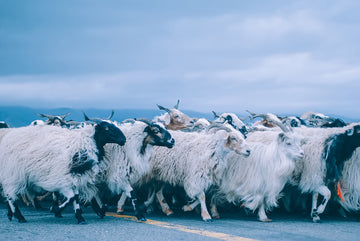There is almost no material in the world that feels as warm and comfortable yet so light as cashmere clothing, and as more people have become aware of the material, its versatility has become even more pronounced.
However, one consequence of its popularity is that because of the scarcity of the goats themselves, the material is very rare and thus exceptionally expensive.
This fact has been known ever since cashmere was first used to make clothes, and many attempts have been made to try and either make more or make other materials feel like cashmere, both of which failed quite dramatically.
The earliest, most ambitious and closest plan to succeeding was the brainchild of France’s first and foremost wool industrialist, which took 20 years to come to fruition and fell apart in less than ten.
Lanceur D’Affaires
As the eldest son of Charles-Louis Ternaux, William-Louis Ternaux (1763-1833) was destined to take over his father's woollen business in Sedan, France.
However, he was not necessarily expected to become one of the biggest entrepreneurs of the French Industrial Revolution, transforming a business with just eight looms into an empire that employed over 3000 people on 150 looms by 1789. By 1823 he was employing over 20,000 people.
At the height of his fame in 1823, around the time his grandest plan and biggest failure would come to fruition, he bet 100,000 francs that there was no manufacturer in Europe as prolific, progressive and experimental as he was.
During the French Revolution, he would hide in exile, but upon his return in 1799 having studied the German, English and Swiss woollens industry, he had a grand plan to make a fortune and eventually win over the most famous cashmere fan in France.
He had gotten his hands on Indian Kashmir shawls and was already attempting to create his own versions using more conventional Spanish merino wool. It was not quite close enough, but it was the start of a much greater plan.
Laine De Perse
Having gotten the ear of Emperor Napoleon Bonaparte’s government, Mr Ternaux managed to get access to real cashmere wool and produce French-made shawls.
However, the time and money costs of getting this wool from the other side of the Silk Road meant that he was always looking for a better solution, and by 1818 it seemed like he had managed it.
Mr Ternaux’s plan, led by diplomat Pierre Jaubert, would involve travelling to Persia, at the time run by the Durrani Empire and including Kashmir itself, and buying as many cashmere goats as they can to start their own herd in France.
It didn’t go well. The year-long round trip would see Mr Jaubert buy 1500 goats, of which only 256 arrived across the Crimea to Toulon and Marseilles.
The Government bought 100 to send to the Perpignan Royal Sheep Farm, and the rest were taken to Saint-Ouen.
He managed to get a few landowners to buy goats, but his plan was largely a failure. The royal herd died out by 1829 and the production of the one French landowner who tried to harvest cashmere was 500g.
Mr Ternaux died in 1833, although by that point 150 cashmere goats still lived.














